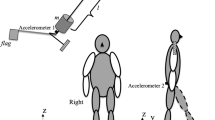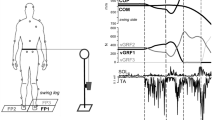Abstract
During the initiation of stepping, anticipatory postural adjustments (APAs) for lateral weight transfer and propulsion normally precede the onset of locomotion. In Parkinson’s disease (PD), impaired step initiation typically involves altered APA ground force production with delayed step onset and deficits in stepping performance. If, as in stance and gait, sensory information about lower limb load is important for the control of stepping, then perturbations influencing loading conditions could affect the step initiation process. This study investigated the influence of changes in lower limb loading during step initiation in patients with PD and healthy control subjects. Participants performed rapid self-triggered step initiation with the impending single stance limb positioned over a pneumatically actuated platform. In perturbation trials, the stance limb ground support surface was either moved vertically downward (DROP) or upward (ELEVATE) by 1.5 cm shortly after the onset of the APA phase. Overall, PD patients demonstrated a longer APA duration, longer time to first step onset, and slower step speed than controls. In both groups, the DROP perturbation reinforced the intended APA kinetic changes for lateral weight transfer and resulted in a significant reduction in APA duration, increase in peak amplitude, and earlier time to first step onset compared with other conditions. During ELEVATE trials that opposed the intended weight transfer forces both groups rapidly adapted their stepping to preserve standing stability by decreasing step length and duration, and increasing step height and foot placement laterally. The findings suggested that sensory information associated with limb load and/or foot pressure modulates the spatial and temporal parameters of posture and locomotion components of step initiation in interaction with a centrally generated feedforward mode of neural control. Moreover, impaired step initiation in PD may at least acutely be enhanced by augmenting the coupling between posture and locomotion.




Similar content being viewed by others
References
Af Klint R, Nielsen JB, Sinkjaer T, Grey MJ (2009) Sudden drop in ground support produces force-related unload response in human overground walking. J Neurophysiol 101:1705–1712
Bachmann V, Müller R, van Hedel HJ, Dietz V (2008) Vertical perturbations of human gait: organization and adaptation of leg muscle responses. Exp Brain Res 186:123–130
Breniere Y, Do MC (1986) When and how does steady state gait movement induced from upright posture begin? J Biomech 19:1035–1040
Brunt D, Lafferty MJ, Mckeon A, Goode B, Mulhausen C, Polk P (1991) Invariant characteristics of gait initiation. Am J Phys Med Rehabil 70:206–212
Burleigh-Jacobs A, Horak FB, Nutt JG, Obeso JA (1997) Step initiation in Parkinson’s disease: influence of levodopa and external sensory triggers. Mov Disord 12:206–215
Carlsoo S (1966) The initiation of walking. Acta Anat 65:1–9
Crenna P, Frigo C (1991) A motor programme for the initiation of forward-oriented movements in humans. J Physiol 437:635–653
Crenna P, Giovannelli P, Piccolo I (1990) The initiation of gait in Parkinson’s disease. In: Berardelli A, Benecke R, Manfredi M, Marsden CD (eds) Motor disturbances II. Academic Press, London, pp 161–173
De Nunzio AM, Nardone A, Picco D, Nilsson J, Schieppati M (2008) Alternate trains of postural muscle vibration promote cyclic body displacement in standing parkinsonian patients. Mov Disord 23:2186–2193
De Nunzio AM, Grasso M, Nardone A, Godi M, Schieppati M (2010) Alternate rhythmic vibratory stimulation of trunk muscles affects walking cadence and velocity in Parkinson’s disease. Clin Neurophysiol 121:240–247
Dietz V, Colombo G (1998) Influence of body load on the gait pattern in Parkinson’s disease. Mov Disord 13:255–261
Dietz V, Duysens J (2000) Significance of load receptor input during locomotion: a review. Gait Posture 11:102–110
Dietz V, Colombo G, Jensen L, Baumgartner L (1995) Locomotor capacity of spinal cord in paraplegic patients. Ann Neurol 37:574–582
Duysens J, Pearson KG (1980) Inhibition of flexor burst generation by loading ankle extensor muscles in walking cats. Brain Res 187:321–332
Duysens J, Clarac F, Cruse H (2000) Load-regulating mechanisms in gait and posture: comparative aspects. Physiol Rev 80:83–133
Gantchev N, Viallet F, Aurenty R, Massion J (1996) Impairment of posturo- kinetic co-ordination during initiation of forward oriented stepping movements in parkinsonian patients. Electromyogr Electroencephalogr Clin Neurophysiol 101:110–120
Giladi N, McDermott MP, Fahn S, Przedborski S, Jankovic J, Stern M, Tanner C (2001) Freezing of gait in PD: prospective assessment in the DATATOP cohort. Neurology 56:1712–1721
Gorassini MA, Prochazka A, Hiebert GW, Gauthier MJ (1994) Corrective responses to loss of ground support during walking. I. Intact cats. J Neurophysiol 71:603–610
Hiebert GW, Gorassini MA, Jiang W, Prochazka A, Pearson KG (1994) Corrective responses to loss of ground support during walking. II. Comparison of intact and chronic spinal cats. J Neurophysiol 71:611–622
Hoehn MM, Yahr MD (1967) Parkinsonism: onset, progression and mortality. Neurology 17:427–442
Jian Y, Winter DA, Ishac MG, Gilchrist L (1993) Trajectory of the body COG and COP during initiation and termination of gait. Gait Posture 1:9–22
Konczak J, Corcos DM, Horak F, Poizner H, Shapiro M, Tuite P, Volkmann J, Maschke M (2009) Proprioception and motor control in Parkinson’s disease. J Mot Behav 41:543–552
Kwon YH (2000) Plate padding. Kwon3D XP website. http://www.kwon3d.com/theory/grf/pad.html. Accessed 23 October 2010
Lyon IN, Day B (2005) Predictive control of body mass trajectory in a two-step sequence. Exp Brain Res 161:193–200
MacKinnon CD, Bissig D, Chuisano J, Miller E, Rudnick L, Yager C, Zhang Y, Mille M-L, Rogers MW (2007) Preparation of anticipatory postural adjustments prior to stepping. J Neurophysiol 97:4368–4379
Mann RA, Hagy JL, White V, Liddell D (1979) The initiation of gait. J Bone Joint Surg 61:232–239
Martin JP (1967) The basal ganglia and posture. Philadelphia, Lippincott
Mille ML, Johnson ME, Martinez KM, Rogers MW (2005) Age-dependent differences in lateral balance recovery through protective stepping. Clin Biomech 20:607–616
Mille M-L, Johnson-Hilliard ME, Martinez K, Simuni T, Rogers MW (2007) Acute effects of a lateral postural assist on voluntary step initiation in patients with Parkinson’s disease. Mov Disord 22:20–27
Mille M-L, Johnson-Hilliard ME, Martinez K, Simuni T, Zhang Y, Rogers MW (2009) Short-term effects of posture-assisted step training on rapid step initiation in Parkinson’s disease. J Neurol Phys Ther 33:88–95
Morris ME, Iansek R, Matyas TA, Summers JJ (1996) Stride length regulation in Parkinson’s disease. Normalization strategies and underlying mechanisms. Brain 119:551–568
Nakazawa K, Kawashima N, Akai M, Yano H (2004) On the reflex coactivation of ankle flexor and extensor muscles induced by a sudden drop of support surface during walking in humans. J Appl Physiol 96:604–611
Nakazawa K, Kawashima N, Akai M (2009) Effect of different preparatory states on the reflex responses of ankle flexor and extensor muscles to a sudden drop of support surface during standing in humans. J Electromyogr Kinesiol 19:782–788
Rogers MW, Kukulka CG, Brunt D, Cain TD, Hanke TA (2001) The influence of stimulus cue on the initiation of stepping in young and older adults. Arch Phys Med Rehabil 82:619–624
Rubinstein TC, Giladi N, Hausdorff JM (2002) The power of cueing to circumvent dopamine deficits: a review of physical therapy treatment of gait disturbances in Parkinson’s disease. Mov Disord 17:1148–1160
Schaafsma JD, Balash Y, Gurevich T, Bartels AL, Hausdorff JM, Giladi N (2003) Characterization of freezing of gait subtypes and the response of each to levodopa in Parkinson’s disease. Eur J Neurol 10:391–398
Shinya M, Oda S (2010) Fast muscle responses to a unexpected foot-in-hole scenario, evoked in the context of prior knowledge of the potential perturbation. Exp Brain Res 203:437–446
Shinya M, Fujii S, Oda S (2009) Corrective postural responses evoked by completely unexpected loss of ground support during human walking. Gait Posture 29:483–487
van der Linden MH, Marigold DS, Gabreëls FJ, Duysens J (2007) Muscle reflexes and synergies triggered by an unexpected support surface height during walking. J Neurophysiol 97:3639–3650
Vaugoyeau M, Viallet F, Mesure S, Massion J (2003) Coordination of axial rotation and step execution: deficits in Parkinson’s disease. Gait Posture 18:150–157
Acknowledgments
The contributions of S. Beuth, T. Diephuis, and M. McCloy to this project are gratefully acknowledged. We thank F. Gao and D. Zhang for their technical assistance.
Author information
Authors and Affiliations
Corresponding author
Rights and permissions
About this article
Cite this article
Rogers, M.W., Hilliard, M.J., Martinez, K.M. et al. Perturbations of ground support alter posture and locomotion coupling during step initiation in Parkinson’s disease. Exp Brain Res 208, 557–567 (2011). https://doi.org/10.1007/s00221-010-2504-z
Received:
Accepted:
Published:
Issue Date:
DOI: https://doi.org/10.1007/s00221-010-2504-z




